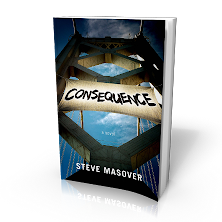You're skimming the shelving carts -- at Moe's Books in Berkeley, for example -- and a skinny little white-spined book catches your eye, who knows how or why. You pick it up, and it has one of those gold "Winner of the Pulitzer Prize" seals on the simple white cover. A tiny figure stands alone in a snowscape printed in blues and greys across the bottom quarter of the paperback. Marilynne Robinson contributed a front-cover blurb pullout and a back-cover blurb. (You deduce from the back-cover bio that Robinson first taught and then taught alongside the author at the University of Iowa Writers' Workshop.) The first sentence of the novel hooks you, and the second sentence sets the hook, then the rest of the paragraph that fills the first page reels you in with its clean, spare specificity:
George Washington Crosby began to hallucinate eight days before he died. From the rented hospital bed, placed in the middle of his own living room, he saw insects running in and out of imaginary cracks in the ceiling plaster. The panes in the windows, once snugly pointed and glazed, stood loose in their sashes. The next stiff breeze would topple them all and they would flop onto the heads of his family, who sat on the couch and the love seat and the kitchen chairs his wife had brought in to accommodate everyone. The torrent of panes would drive everyone from the room, his grandchildren in from Kansas and Atlanta and Seattle, his sister in from Florida, and he would be marooned on his bed in a moat of shattered glass. Pollen and sparrows, rain and the intrepid squirrels he had spent half of his life keeping out of the bird feeders would breach the house.
I bought the novel in June, and read it twice through in five weeks.
TINKERS is about a man, a dying old man, whose last days are spent inhabiting, as in a fantastically vivid dream, the life and mind of his odd, eccentric, impoverished, epileptic father, whose life forked away from his own when George Washington Crosby was an eleven year old boy, or perhaps just twelve.
It's also about how clocks work, because fixing old clocks is what George did for the last thirty years of his life, after retiring from a teaching job. It's about building bird nests, in imitation of birds' techniques, with false beaks cut from tinkers' tin tied onto one's fingertips. It's about winters in New England. It's about George's father Howard selling bits and pieces of manufactured goods out of a cart fitted with wooden drawers with a brass pull-ring on each, a cart pulled by a mule named Prince Edward down "dirt tracks that ran into the deep woods to hidden clearing where a log cabin sat among sawdust and tree stumps..." It's about what epilepsy feels like from inside.
Why did this short, quiet novel, its author's first, shoulder its way to the front of my reading queue? And demand a second read so soon after the first?
I was wide open to it, I know that now, having read it: my own father passed in late November of last year. His brother, the last of his siblings, died in June. I've been anticipating the wedding of a dear cousin, granddaughter of my father's late sister, who was married this past weekend. A relative whose precise connection -- through my paternal grandfather -- isn't fully clear yet had recently been in touch from Barcelona, where she was traveling, all afire with the dim inference we share that some five centuries ago our family was shown the Spanish border after working for generations prior to the expulsion of 1492 as farm foremen (an occupation called "Masover" in Catalan, pronounced maj-o-vay, or something close to that).
All of which is to say: I've had family, generations, and the occasions of families' lives, on my mind.
So a novel treating a son seeking his long-lost father -- known only through dim memories, old diaries, the deductions made from what a son finds in his own body, heart, and mind, deeply structural artifacts that can only have lodged in him as bequeathed character -- well, a story like that had no choice but to lure me in. How do we know our fathers? Through what narrow slices of their lives do we learn of them? What do we discover about our fathers when we come around to understanding ourselves?
TINKERS is one of those novels that is less about plot and more about revelation of character through incident. Intricately interweaving glimpses of his father's life that may be imagined or inferred or drawn from the deepest well of himself, and memories of his own life, both the years lived with his father and over the many decades of their separation, Harding's George Washington Crosby opens a view, vertiginously deep, of what it means to find, and have, and lose a seemingly-autonomous identity (but, in Harding's vision, only seemingly).
It's a Pulitzer Prize winner that's well worth reading, however belatedly. It's worth reading twice. Thanks, Moe, gone but certainly not forgotten; and thanks to every other intrepid, independent bookstore owner ... for keeping bookstore serendipity alive.
Related posts on One Finger Typing:
Robert Redford, the Weather Underground, and why we read books
Ursula Le Guin visits UC Berkeley
The lives of books
Thanks to Matthew Felix Sun for the photo of The Last Bookstore in downtown Los Angeles, taken during our recent visit.











